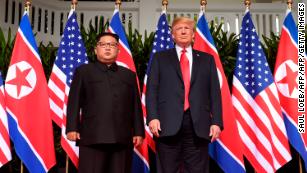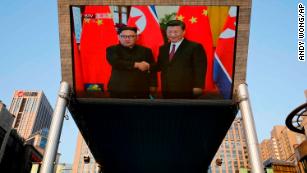Satellite images show North Korea upgrading nuclear facility
Updated 2225 GMT (0625 HKT) June 27, 2018

Washington (CNN)New
satellite images show North Korea has made rapid improvements to the
infrastructure at its Yongbyon Nuclear Scientific Research Center -- a
facility used to produce weapons-grade fissile material, according to an
analysis published by 38 North, a prominent North Korea monitoring
group.
Captured on
June 21, the photos reveal modifications to the site's plutonium
production reactor and the construction of several support facilities --
long-planned upgrades that were already underway before North Korean
leader Kim Jong Un and US President Donald Trump met in Singapore
earlier this month.
When
contacted by CNN about 38 North's analysis, the Unification Ministry
said they "cannot confirm the report" and are "watching it closely."
The
report states that "continued work at the Yongbyon facility should not
be seen as having any relationship to North Korea's pledge to
denuclearize," but the photos suggest that Pyongyang continues to
proceed with business as usual when it comes to maintaining its nuclear
sites following the summit.
"No
change is actually a pretty significant story ... this is still an
active site producing plutonium for North Korea," according to Jeffrey
Lewis, a professor at the Middlebury Institute of International Studies.
The images stand in stark contrast to Trump's recent declaration that the North Korean regime
no longer poses a nuclear threat, even though the meeting produced no
verifiable proof that North Korea will discontinue its nuclear program.
Secretary of State Mike Pompeo said Wednesday that North Korea remains a nuclear threat, but defended Trump's previous comment.
"I'm
confident what he intended there was we did reduce the threat," said
Pompeo. "I don't think there's any doubt about that. We took the tension
level down."
"I think his point was a fair one," he added. "For the moment, we have reduced risk."
But
Trump has repeatedly mischaracterized the nature of his deal with Kim,
insisting last week that the North Korean dictator had agreed to begin
"total denuclearization" right away.
In
reality, the document he signed with Kim at their June 12 summit in
Singapore only reiterated North Korea's previous commitment to "work
toward complete denuclearization of the Korean Peninsula," and the new
images released Wednesday align with Defense Secretary James Mattis' assessment that Pyongyang remains in a holding pattern as negotiators discuss the next steps in talks.
"The
summit pledge is important, but it was not a written agreement that
laid out what the North Koreans have to do -- that doesn't exist right
now, so I'm not surprised they are continuing to operate their
facilities," said Joel Wit, a Senior Fellow at the Stimson Center and
Director of 38 North.
Adam Mount, a senior fellow and director at the Federation of American Scientists, agreed that the images
indicate that North Korea will continue to support the foundation of
its nuclear program until the two sides are able to agree on specific
terms.
"Because Kim Jong Un has so
far avoided making a commitment to halt research and development
activities, the changes are not a success or failure of the diplomatic
process, but simply a signal that North Korea's nuclear infrastructure
remains fully in use," Mount told CNN.
"That
Yongbyon continues to receive scarce funds speaks to its continued
value to the regime. There is little indication that North Korea has
halted research, development, or production of nuclear systems even as
talks continue," he added.
North
Korea also maintains other nuclear facilities where they produce the
bulk of their nuclear weapons materials and missiles. While these sites
cannot be detected by monitoring groups, they are assumed to remain
operational, according to Wit.
Trump
has often pointed to the absence of North Korean missile and nuclear
tests in recent months as a sign of progress toward denuclearization,
but continued maintenance of facilities like Yongbyon show that talks
with the US have not yet prompted Kim to take significant steps toward
truly dismantling the foundation of his program.
"Both
secret and Yongbyon facilities can continue operating and expand the
fissile material stockpile," Vipin Narang, an associate professor of
political science at the Massachusetts Institute of Technology who
studies nuclear proliferation, told CNN.
"We
have no way to stop this or verify any pledges to freeze," he said,
noting that Kim has intentionally only agreed to freeze full blown
testing, not production.
North Korea can also continue to improve its warhead and ballistic designs without conducting tests, Narang added.
"North
Korea has had a decade-long nuclear testing sequence where they have
presumably learned a lot about designs," he told CNN. "They probably do
not need full blown tests to go into serial production of warheads. And
they can improve components and perfect designs with subcritical and
hydrodynamic tests which we wouldn't be able to monitor or detect."
Ultimately,
38 North's analysis of these images provides a realistic look at the
current state of North Korea's nuclear program amid talks with the US
and the challenges facing negotiators tasked with achieving
denuclearization -- a process for which Pompeo has refused to offer a
timeline.
"We should remain
skeptical that North Korea's nuclear calculus has changed dramatically.
Every indication since the beginning of the year is that Pyongyang is
seeking to exploit diplomacy to its advantage, including by continuing
to improve its arsenal," Mount told CNN. "Halting a clearly-defined list
of weapons activities should be the first step in negotiations."
"What
is needed now is sustained and direct negotiations between the two
sides on a framework for phased steps on denuclearization, as well as
concrete steps toward a peace regime on the Korean peninsula," according
to Kingston Reif, director for disarmament and threat reduction policy
at the Arms Control Association.
"So far, such a framework has not been established. In other words, there is no 'deal,'" he said.
Washington (CNN)New
satellite images show North Korea has made rapid improvements to the
infrastructure at its Yongbyon Nuclear Scientific Research Center -- a
facility used to produce weapons-grade fissile material, according to an
analysis published by 38 North, a prominent North Korea monitoring
group.
Captured on
June 21, the photos reveal modifications to the site's plutonium
production reactor and the construction of several support facilities --
long-planned upgrades that were already underway before North Korean
leader Kim Jong Un and US President Donald Trump met in Singapore
earlier this month.
When
contacted by CNN about 38 North's analysis, the Unification Ministry
said they "cannot confirm the report" and are "watching it closely."
The
report states that "continued work at the Yongbyon facility should not
be seen as having any relationship to North Korea's pledge to
denuclearize," but the photos suggest that Pyongyang continues to
proceed with business as usual when it comes to maintaining its nuclear
sites following the summit.
"No
change is actually a pretty significant story ... this is still an
active site producing plutonium for North Korea," according to Jeffrey
Lewis, a professor at the Middlebury Institute of International Studies.
The images stand in stark contrast to Trump's recent declaration that the North Korean regime
no longer poses a nuclear threat, even though the meeting produced no
verifiable proof that North Korea will discontinue its nuclear program.
Secretary of State Mike Pompeo said Wednesday that North Korea remains a nuclear threat, but defended Trump's previous comment.
"I'm
confident what he intended there was we did reduce the threat," said
Pompeo. "I don't think there's any doubt about that. We took the tension
level down."
"I think his point was a fair one," he added. "For the moment, we have reduced risk."
But
Trump has repeatedly mischaracterized the nature of his deal with Kim,
insisting last week that the North Korean dictator had agreed to begin
"total denuclearization" right away.
In
reality, the document he signed with Kim at their June 12 summit in
Singapore only reiterated North Korea's previous commitment to "work
toward complete denuclearization of the Korean Peninsula," and the new
images released Wednesday align with Defense Secretary James Mattis' assessment that Pyongyang remains in a holding pattern as negotiators discuss the next steps in talks.
"The
summit pledge is important, but it was not a written agreement that
laid out what the North Koreans have to do -- that doesn't exist right
now, so I'm not surprised they are continuing to operate their
facilities," said Joel Wit, a Senior Fellow at the Stimson Center and
Director of 38 North.
Adam Mount, a senior fellow and director at the Federation of American Scientists, agreed that the images
indicate that North Korea will continue to support the foundation of
its nuclear program until the two sides are able to agree on specific
terms.
"Because Kim Jong Un has so
far avoided making a commitment to halt research and development
activities, the changes are not a success or failure of the diplomatic
process, but simply a signal that North Korea's nuclear infrastructure
remains fully in use," Mount told CNN.
"That
Yongbyon continues to receive scarce funds speaks to its continued
value to the regime. There is little indication that North Korea has
halted research, development, or production of nuclear systems even as
talks continue," he added.
North
Korea also maintains other nuclear facilities where they produce the
bulk of their nuclear weapons materials and missiles. While these sites
cannot be detected by monitoring groups, they are assumed to remain
operational, according to Wit.
Trump
has often pointed to the absence of North Korean missile and nuclear
tests in recent months as a sign of progress toward denuclearization,
but continued maintenance of facilities like Yongbyon show that talks
with the US have not yet prompted Kim to take significant steps toward
truly dismantling the foundation of his program.
"Both
secret and Yongbyon facilities can continue operating and expand the
fissile material stockpile," Vipin Narang, an associate professor of
political science at the Massachusetts Institute of Technology who
studies nuclear proliferation, told CNN.
"We
have no way to stop this or verify any pledges to freeze," he said,
noting that Kim has intentionally only agreed to freeze full blown
testing, not production.
North Korea can also continue to improve its warhead and ballistic designs without conducting tests, Narang added.
"North
Korea has had a decade-long nuclear testing sequence where they have
presumably learned a lot about designs," he told CNN. "They probably do
not need full blown tests to go into serial production of warheads. And
they can improve components and perfect designs with subcritical and
hydrodynamic tests which we wouldn't be able to monitor or detect."
Ultimately,
38 North's analysis of these images provides a realistic look at the
current state of North Korea's nuclear program amid talks with the US
and the challenges facing negotiators tasked with achieving
denuclearization -- a process for which Pompeo has refused to offer a
timeline.
"We should remain
skeptical that North Korea's nuclear calculus has changed dramatically.
Every indication since the beginning of the year is that Pyongyang is
seeking to exploit diplomacy to its advantage, including by continuing
to improve its arsenal," Mount told CNN. "Halting a clearly-defined list
of weapons activities should be the first step in negotiations."
"What
is needed now is sustained and direct negotiations between the two
sides on a framework for phased steps on denuclearization, as well as
concrete steps toward a peace regime on the Korean peninsula," according
to Kingston Reif, director for disarmament and threat reduction policy
at the Arms Control Association.
"So far, such a framework has not been established. In other words, there is no 'deal,'" he said.





















Comments
Post a Comment
Thanks, If you don't like our service tell us, if you like our blog, tell and invite your friends. we are here to give all you want